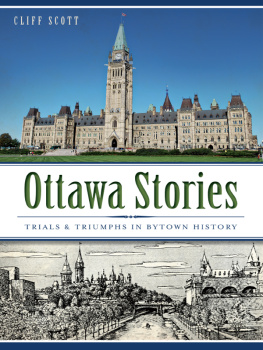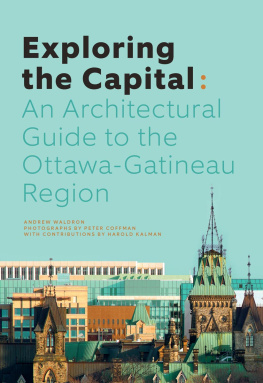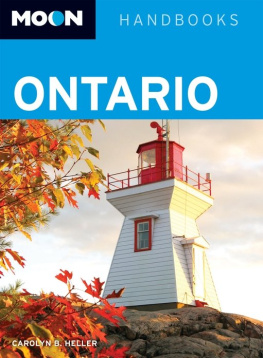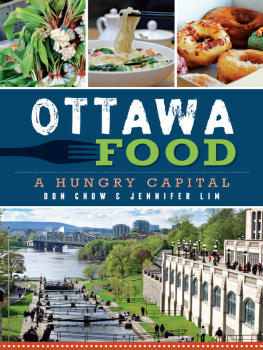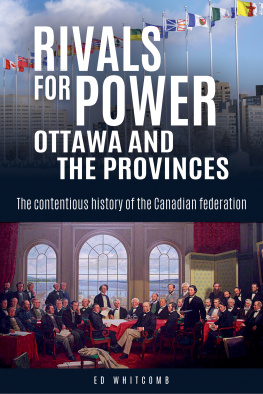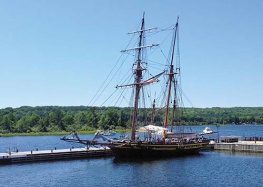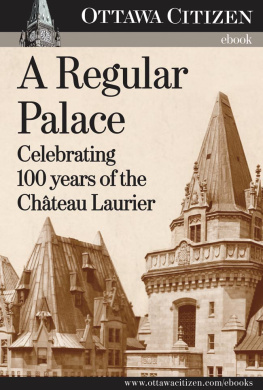

Published by The History Press
Charleston, SC 29403
www.historypress.net
Copyright 2014 by Cliff Scott
All rights reserved
First published 2014
e-book edition 2014
ISBN 978.1.62584.833.8
Library of Congress Cataloging-in-Publication Data
Scott, Cliff.
Ottawa stories : trial and triumphs in Bytown history / Cliff Scott.
page cm
print edition ISBN 978-1-62619-341-3
1. Ottawa (Ont.)--History. 2. Ottawa (Ont.)--Social life and customs. 3. Ottawa (Ont.)--Biography. I. Title.
F1059.5.O9S35 2014
971.384--dc23
2014014066
Notice: The information in this book is true and complete to the best of our knowledge. It is offered without guarantee on the part of the author or The History Press. The author and The History Press disclaim all liability in connection with the use of this book.
All rights reserved. No part of this book may be reproduced or transmitted in any form whatsoever without prior written permission from the publisher except in the case of brief quotations embodied in critical articles and reviews.
Contents
Introduction
I first saw Ottawa from a train window in the spring of 1954 when I reported for duty in the Royal Canadian Air Force (RCAF). I saw the Parliament buildings from the Hull side of the river (as it was then), surrounded by fresh greenery, and I fell in love. Except for going west for a while for postings and schooling, this city has been my home ever since.
Fishing, swimming, sleigh rides and hiking have been a part of my life, as well as marrying a girl from the valley and raising a family. I have worked here, earned my living, coached baseball and grew even fonder of my city over time. Sharing local stories at family pig roasts, learning local history, running a small museum and getting immersed in local heritage gave me an even better feel for the place and an incentive to tell others about Ottawa.
This is, therefore, an attempt to pull together a local background and share stories. It is not a formal or official history but rather an inspiration to those who want to know more. If a story intrigues you, then I hope you will go to one of the sources identified, or others like them, and learn more about people and things that have made Ottawa a fascinating, historical and simply wonderful place to live.
A special thanks to my son and daughter, who helped gather pictures, research and type, as well as to my wife, who put up with an old curmudgeon while the book was being written.
PART I
The Birth of Bytown
EARLY ORIGINS OF OTTAWA
As far as the First Nations are concerned, archaeologists tell us that there are sites dating back to circa 8000 BCE. The Ottawa and St. Lawrence Rivers were a dividing line for native people in the sense that the Iroquois nations lived south of the St. Lawrence, the Hurons west of the Ottawa and the Algonquins north and east of the Ottawa. These were not hard-and-fast dividing lines, and there was surely some spillover between the areas that caused conflict from time to time. During the French regime, the Ottawa was the highway to the fur-producing areas to the northwest. This continued after the English took over in 1763, and the Ottawa also became the highway for the timber trade, which was really to blossom in the mid-eighteenth century. A navigational instrument belonging to Samuel de Champlain was discovered not far from Ottawa dating back to the early seventeenth century. The songs and chanteys of the voyageurs were probably some of the only sounds heard along the river for close to two hundred years.
In the early seventeenth century, the rivers also served as the route that Jesuit missionaries took to live among the Hurons at Ste. Marie Among the Hurons, until the mission was destroyed by the Iroquois in 1634. For various reasons too complex to mention here, the Iroquois always tended to side with the British. This was the case even after the United States declared independence in 1776. The situation changed near Ottawa after 1783, when the United States became fully independent of Britain and a group of people known as United Empire Loyalists began to settle along the St. Lawrence and up country from there. These were people who had supported Britain during the war from 1776 to 1783 and, with the exception of in South Carolina, were no longer welcome in the United States. Their lands and properties were expropriated for U.S. supporters, and they had to seek new homes. Land was made available to them in Eastern Ontario by the British government.
These land grants grew after the War of 1812 as the British government wanted the land taken up by those loyal to Britain and not likely to join the republic to the south. These settlements were supported by Sir Guy Carleton, governor of Canada until 1796, who was aided by Sir Evan Nepean of the British colonial office. Their names are still evident in the area today. In 1791, there were only 20,000 settlers in all of Upper Canada compared to 130,000 in Quebec. This was another reason English people were wanted in the area and the next settlement waves supported this policy before 1826. A number of people came up from Vermont. Some of the native names appearing on those treaties are amusing choices: Shabisi (a rough bird), Kakadas (big mud fish) and Nitwasinini (a windy man). One can only guess why someone was called a windy man.
Settlers came in from many lands and for varied reasonsHighland Scots from the clearances; Irish for canal work and later because of the potato famine; veterans of the Napoleonic wars; Irish protestants, who settled near Almonte; and Scottish and English to work on the Rideau Canal. Aside from land records, there are historical sources for the names of the settlers in most of the areas around Ottawa. Beldens Historical Atlas of 1879 even shows where people settled in detail. Gourlays 1892 History of the Ottawa Valley gives much detailed information but is incredibly difficult to use as it has no chapters or table of contents and is just a continuous narrative from beginning to end. Carleton Saga (a more recent book, produced in 1968) along with G. Lockwoods histories of certain townships are further sources of information. Wherever they came from, they were the impetus for the stories that followfrom semi-legendary figures like Big Joe Mufferaw and Mother McGinty to historical figures such as John By and more modern personalities like the controversial mayor of Ottawa Charlotte Whitton. Its a pleasure to tell their stories!
THE EARLY SETTLERS AND THEIR STORIES
Some of the names that have come down to us are given in a following section, so perhaps readers can determine if they are descended from some of these first people. Carleton County, where Ottawa rests, was established by an act of King George III, and great detail is available in H. Beldens historical atlas and Gourlays history. Bytown, which became Ottawa in 1854, was the principal town in the county. Soldiers appear firstveterans of the Napoleonic wars and the War of 1812. They were encouraged to settle in Upper Canada, especially near the border with the United States in case there was an encore of the War of 1812.
The first recorded political representative of the British government was Colonel Burke of His Majestys 99th Regiment in Brockville. Other military names that appear include Colonels Lyons and Lewis near Richmond, as well as Malloch, Stewart, Pinhey and James Johnston. Nonmilitary names include Ormsby, Street, Edwards, Aumond, Stephenson, McKinnon, McTaggart, Fenton, Freeman, Petry, Bradley, Durie, Hinton, Pinhey and McElroy. Other military names appear in 1854, associated with the 1st Rifles: Patterson, Fraser, Abbott, Grant, May, Mowat, Esmonde, McCuaig and Lang. In the town of Bytown in 1832, right after the canal was completed, we find Colonel John By, who arrived in September 1826, accompanied by J. Clowe, who designed the route of the canal. There was also Caleb T. Bellows, who had a dock and a general store prior to 1820, and Nicholas Sparks, who was from across the river in Wrightville.
Next page
